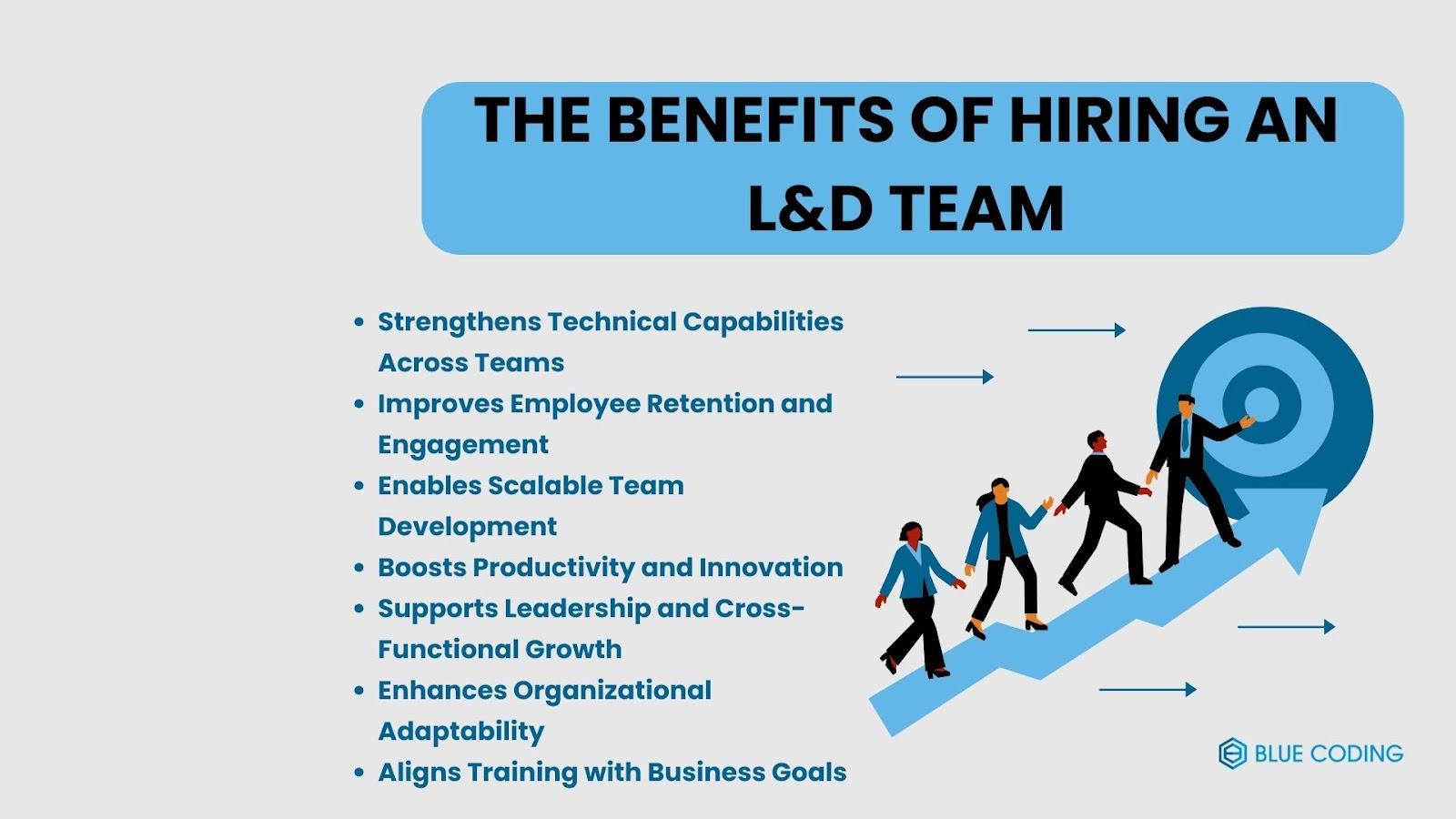 News
News
Keeping teams skilled and adaptable is critical and essential now. A Learning and Development (L&D) team ensures continuous growth by aligning training with your company’s goals and technologies. Beyond corporate training and upskilling solutions and organizing courses, they build a culture of learning that strengthens technical capabilities, improves retention, and supports scalable team growth. For companies with nearshore developers, an effective L&D in software companies functions to bridge skill gaps across regions, enhances collaboration, and keeps teams future-ready. With structured learning in place, your developers evolve, innovate, and drive long-term business success.
The Benefits of Hiring an L&D Team
1. Strengthens Technical Capabilities Across Teams.
In software development, technologies evolve faster than job titles can keep up. A dedicated Learning and Development team structure helps bridge that gap by ensuring developers are always in sync with the latest programming languages, frameworks, and tools. Rather than relying on occasional training sessions, an L&D team builds a continuous learning framework that integrates seamlessly into your company’s workflow. For nearshore development teams, this becomes especially valuable. With an in-house or partner-led L&D team, you can upskill developers across different regions without interrupting productivity. Developers gain access to consistent training modules on relevant stacks such as React Native, Node.js, and AI integrations, all tailored to your organization’s specific project requirements. Over time, this steady investment reduces skill gaps and builds a more confident, self-reliant team capable of handling complex client needs.
2. Improves Employee Retention and Engagement.
For remote or nearshore developers, professional growth is often a key motivator to stay. When developers see that your company invests in their learning journey, they are more likely to remain loyal and engaged. An L&D team does more than train employees; it cultivates a culture of curiosity and self-improvement. In nearshore setups, where cultural alignment and communication already play a big role, this added investment makes collaboration more meaningful. Developers feel included in the company’s long-term vision, not just hired for a temporary project. By helping developers grow into team leads, solution architects, or full-stack experts, your organization not only saves on turnover costs but also nurtures leadership from within. A proper Learning and Development team structure functions to turn software professionals into long-term partners, directly enhancing client satisfaction and project consistency.
3. Enables Scalable Team Development.
Hiring an L&D team also allows you to scale your software development capabilities without compromising quality. Instead of retraining every new hire from scratch, an L&D department standardizes the onboarding and skill-building process. Whether you are onboarding five or fifty nearshore developers, everyone receives the same level of technical and cultural training. At Blue Coding, we often see companies struggle when scaling remote teams quickly. Knowledge gaps, inconsistent coding practices, and unclear communication processes become major bottlenecks. With an L&D structure in place, these risks are minimized. New hires quickly understand your workflow, project tools, and best practices. This makes scaling nearshore development teams not only faster but also more predictable, ensuring your company maintains the same delivery quality across all projects.

4. Boosts Productivity and Innovation.
Continuous learning has a direct impact on productivity. Developers who regularly engage in structured training sessions are faster at solving technical challenges, more creative in their approach, and better aligned with modern development methodologies such as DevOps, CI/CD, and Agile workflows.
With an L&D team, innovation becomes part of your company’s culture. Instead of waiting for challenges to arise, your developers proactively explore smarter solutions, new automation methods, and optimization opportunities. For example, your team might discover more efficient APIs, adopt improved testing practices, or streamline deployment pipelines simply because their training encourages experimentation. For nearshore teams, this culture of innovation bridges distance and fosters collaboration across time zones. Developers work smarter and more efficiently, which translates into measurable business growth.
5. Supports Leadership and Cross-Functional Growth.
An L&D team’s role goes beyond technical training. It also nurtures leadership and communication skills among developers. In a remote or nearshore setup, soft skills often make the difference between a team that functions and a team that thrives. By guiding leadership communication, project ownership, and time management, your L&D team prepares developers to step into senior roles with confidence. This is especially valuable for nearshore teams collaborating with global clients. Developers trained in leadership and cross-functional collaboration can handle direct client interactions, manage project segments, and lead distributed teams effectively. The long-term benefit is clear. You reduce dependence on external management layers and cultivate leaders who already understand your culture and codebase.
6. Enhances Organizational Adaptability.
In today’s tech ecosystem, adaptability is just as important as skill. A company’s ability to pivot quickly, whether due to new market demands or emerging technologies, depends on the agility of its teams. With an L&D team in place, your organization can respond to change more efficiently. For example, if a client requests a shift from PHP to Python or wants to integrate AI-based features, your developers will not have to scramble for external training. Instead, your L&D specialists can design a focused learning sprint that helps your team adapt quickly. This agility is instrumental in nearshore partnerships, where time-to-market often determines client satisfaction. By having a flexible learning infrastructure, you maintain your competitive edge and ensure your developers remain future-ready.
7. Aligns Training with Business Goals.
One of the greatest advantages of having a dedicated L&D function is alignment. Traditional external training programs rarely match your company’s vision, but an internal or partner-led L&D team ensures that every learning initiative directly supports your business goals. If your company’s focus is on scaling fintech or eCommerce projects, your L&D team can create specialized tracks for API security, cloud architecture, or scalability optimization. This ensures developers gain knowledge that directly enhances the company’s delivery capabilities. At Blue Coding, this alignment between learning and growth is what transforms software teams into strategic assets.
Strategies to Help Your L&D and Nearshore Developer Teams Function in Harmony
➤ Encourage Cross-Learning Between Teams.
Create shared learning opportunities where L&D specialists and developers collaborate on real projects. Let developers offer feedback on training relevance while L&D experts fine-tune sessions based on project realities. This two-way exchange keeps both sides aligned and makes training more practical.
➤ Hold Regular Alignment Sessions.
Schedule short but consistent syncs between your L&D team and project managers to discuss ongoing developer performance, learning gaps, and new technology needs. These meetings ensure that learning goals evolve alongside project goals rather than functioning as separate priorities.
➤ Leverage Collaborative Tools for Transparency.
Use project management and communication platforms to share learning progress, milestones, and outcomes with both L&D and nearshore teams. When everyone can see who’s learning what and how it connects to current projects, accountability and motivation increase.
➤ Personalize Training Paths for Different Roles.
Not every developer learns the same way. Let your L&D team design tailored learning paths for front-end, back-end, or full-stack developers based on real challenges they face in your nearshore environment. Personalized training fosters stronger engagement and faster progress.
➤ Celebrate Small Wins Together.
Recognize when developers apply new skills successfully or when the L&D team launches a helpful program. A simple acknowledgment in a team meeting or a shared internal post strengthens the culture of collaboration and shared success.
➤ Create Mentorship Bridges.
Pair experienced developers with newer team members and let the L&D team support these mentorships through structured guidance and resources. This strengthens knowledge transfer while giving both teams a sense of ownership over skill growth.
➤ Establish a Shared Performance Framework.
Build a unified metric system that measures both technical performance and learning progress. For example, track improvements in code quality, delivery speed, and problem-solving after specific learning sessions. When both teams operate under the same success criteria, collaboration becomes more goal-oriented.
➤ Encourage Cultural Integration Through Soft-Skill Sessions.
Since nearshore teams work across borders, soft-skill training in communication, cultural awareness, and collaboration can make a major difference. When developers and L&D professionals understand each other’s working styles, teamwork feels natural rather than forced.
➤ Keep Communication Open and Honest.
Encourage feedback from developers on how the learning programs are helping them perform better. Likewise, let the L&D team share insights on where they see room for improvement. Open dialogue creates trust and helps both groups function as one team instead of two departments.
➤ Make Learning Part of Your Workflow.
Integrate short, accessible learning moments into developers’ daily routines rather than setting aside separate time for training. A few minutes spent reviewing quick lessons or case studies during active projects keeps learning consistent without slowing down delivery.
Building Smarter Teams Through Continuous Learning
Every successful software team thrives through consistent learning, shared expertise, and strong collaboration. That is where our approach comes in. We focus on helping companies build nearshore development teams that evolve with every project, supported by structured learning and development strategies that keep skills sharp and mindsets future-focused. Our model blends talent with tailored growth. Developers do not just deliver results; they learn, adapt, and innovate alongside your business goals. Through ongoing training, mentorship programs, and role-specific upskilling, we help create teams that stay aligned, confident, and ready to take on tomorrow’s challenges with ease. Looking to strengthen your nearshore software development capabilities? Contact us today to start building a smarter, more agile team. We will gladly book you a free discovery call to help you out with your initial queries!



